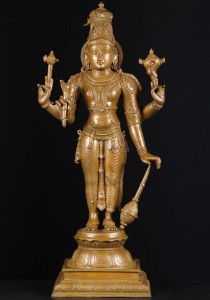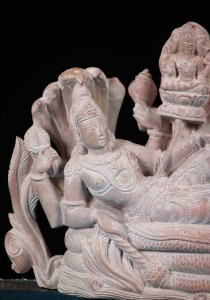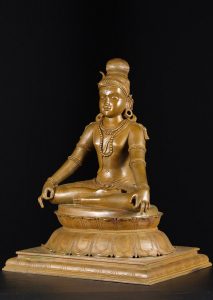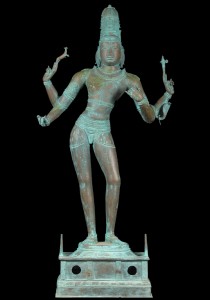In the early centuries of the Common Era, sectarian strife was a major issue between the followers of Shiva and the followers of Vishnu. With the advent of Advaita or non-dualistic philosophy, the differences between these two sects and many others have been partially reconciled. The unity of the major god’s Shiva and Vishnu has become increasingly popular, and many temples now house the image of Hari-Hara.

The iconographical depiction of Hari-Hara or Shankara-Narayana combines the two deities, Shiva and Vishnu, into a single body. The icon itself is aesthetically pleasing; however, the underlying philosophy is even more beautiful.
The Hindu trinity is comprised of Brahma, the creator, Vishnu the preserver, and Shiva the dissolver. Brahma represents the creation of the universe, this world, and everything within it. There is no way to refuse that the creation of all that surrounds us, as well as ourselves, is astonishing. Therefore Brahma does not find himself to be the subject of sectarian division. The argument instead revolves around the relative greatness of Vishnu, the guardian of Brahma’s creation versus Shiva, the one capable of destroying the entire creation and providing a blank canvas for Brahma to begin again.

When looking at the descriptions of Shiva and Vishnu according to various texts, it is interesting to see the juxtaposition between them. Vishnu, who represents the Sattvic Guna is depicted as cloudy black in color, while Shiva who represents the Tamasic Guna is depicted as crystalline white. If that is not confusing enough, Vishnu who is responsible for the protection of the world is depicted as lounging on the back of a snake in the depths of the ocean while Shiva who is responsible for various culminations, one of which being sleep, is depicted as ever-awake and deep in contemplation.

While perplexing at first, the hidden symbolism is very significant. Vishnu is described to be the color of a dark rain cloud. In this context, he is associated with water, which is appropriate because water is the basic necessity of survival. Only with water can plants grow to be later used for food, lumber, and clothing. Shiva is described to be the color of ash. From his third-eye emanates a ferocious fire. Fire is the basic element that causes destruction and stimulates renewal. After burning anything, the result is white ash, which represents the transient nature of life. The cycle of life can also be understood in the context of this symbolism. Vishnu resides in the bottom of the ocean while Shiva resides at the top of the Himalayas. This shows how man starts at the very bottom and is nurtured by Vishnu, then as he gains knowledge, prosperity, and energy (think Saraswathi, Lakshmi, and Parvathi!) he soars to the heights of this world and will eventually receive Moksha, another culmination granted by Shiva.
While this is only a drop in the vast ocean of symbolism and philosophy regarding these two major deities, it is an introduction to understanding the profound beauty behind the sculpture of Hari Hara. On the right stands Shiva, clad in tiger skins and yielding the ax that cuts our ties to this universe. On the left stands Vishnu clad in silk garments and yielding the conch that signals the victory of good and the mace that represents the power of the mind and body. Together on a single pedestal they stand and reassure us that our good qualities will be preserved and our bad qualities destroyed.
śivasya hridayam viṣṇur viṣṇoscha hridayam śivaḥ
Vishnu is the heart of Shiva; Shiva is the heart of Vishnu
~Svasti~

